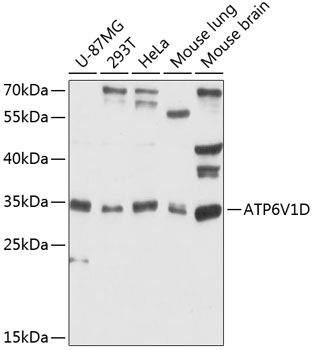V-ATPase D antibody
GTX119155
ApplicationsWestern Blot, ImmunoHistoChemistry, ImmunoHistoChemistry Paraffin
Product group Antibodies
ReactivityHuman, Mouse
TargetATP6V1D
Overview
- SupplierGeneTex
- Product NameV-ATPase D antibody
- Delivery Days Customer9
- Application Supplier NoteWB: 1:500-1:3000. IHC-P: 1:100-1:1000. *Optimal dilutions/concentrations should be determined by the researcher.Not tested in other applications.
- ApplicationsWestern Blot, ImmunoHistoChemistry, ImmunoHistoChemistry Paraffin
- CertificationResearch Use Only
- ClonalityPolyclonal
- Concentration1 mg/ml
- ConjugateUnconjugated
- Gene ID51382
- Target nameATP6V1D
- Target descriptionATPase H+ transporting V1 subunit D
- Target synonymsATP6M, VATD, VMA8, V-type proton ATPase subunit D, ATPase, H+ transporting lysosomal, member M, ATPase, H+ transporting, lysosomal (vacuolar proton pump), ATPase, H+ transporting, lysosomal 34kDa, V1 subunit D, H(+)-transporting two-sector ATPase, subunit M, V-ATPase 28 kDa accessory protein, V-ATPase D subunit, V-ATPase subunit D, vacuolar ATP synthase subunit D, vacuolar H-ATPase subunit D, vacuolar proton pump D subunit, vacuolar proton pump delta polypeptide, vacuolar proton pump subunit D, vacuolar proton-ATPase subunit D
- HostRabbit
- IsotypeIgG
- Protein IDQ9Y5K8
- Protein NameV-type proton ATPase subunit D
- Scientific DescriptionThis gene encodes a component of vacuolar ATPase (V-ATPase), a multisubunit enzyme that mediates acidification of eukaryotic intracellular organelles. V-ATPase dependent organelle acidification is necessary for such intracellular processes as protein sorting, zymogen activation, receptor-mediated endocytosis, and synaptic vesicle proton gradient generation. V-ATPase is composed of a cytosolic V1 domain and a transmembrane V0 domain. The V1 domain consists of three A and three B subunits, two G subunits plus the C, D, E, F, and H subunits. The V1 domain contains the ATP catalytic site. The V0 domain consists of five different subunits: a, c, c, c, and d. Additional isoforms of many of the V1 and V0 subunit proteins are encoded by multiple genes or alternatively spliced transcript variants. This gene encodes the V1 domain D subunit protein. [provided by RefSeq]
- ReactivityHuman, Mouse
- Storage Instruction-20°C or -80°C,2°C to 8°C
- UNSPSC12352203
References
- Domingo-Gonzalez R, Das S, Griffiths KL, et al. Interleukin-17 limits hypoxia-inducible factor 1α and development of hypoxic granulomas during tuberculosis. JCI Insight. 2017,2(19):pii: 92973. doi: 10.1172/jci.insight.92973.Read this paper




